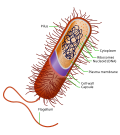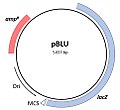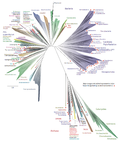Bacteria (redirect from Eubacteria)
prokaryotic life to consist of two separate domains, originally called Eubacteria and Archaebacteria, but now called Bacteria and Archaea that evolved independently...
143 KB (15,532 words) - 00:56, 20 September 2024
(Animalia, Plantae, Fungi, Protista, Archaea/Archaebacteria, and Bacteria or Eubacteria), while textbooks in other parts of the world, such as Bangladesh, Brazil...
74 KB (4,819 words) - 10:10, 4 November 2024
Marine botany (section Eubacteria)
subkingdoms: Eubacteria and Archaebacteria. Eubacteria include the only bacteria that contain chlorophyll a. Not only that, but Eubacteria are placed in...
7 KB (752 words) - 07:49, 18 October 2024
analysis, prokaryotes are divided into two domains: Bacteria (formerly Eubacteria) and Archaea (formerly Archaebacteria). Organisms with nuclei are placed...
44 KB (4,782 words) - 21:35, 2 October 2024
body, filament, and hook. The long filament is the organ which helps eubacteria move.[citation needed][citation needed] Eubacterium on www.bacterio.cict...
3 KB (73 words) - 02:58, 4 October 2024
cellular life Prokaryota / Procarya (Monera) Bacteria Bacteria Monera Eubacteria Bacteria Archaea Archaea Archaebacteria Archaea including eukaryotes Eukaryota...
12 KB (1,293 words) - 03:34, 27 October 2024
sequences: A reappraisal of evolutionary relationships among archaebacteria, eubacteria, and eukaryotes". Microbiol. Mol. Biol. Rev. 62 (4): 1435–91. doi:10.1128/MMBR...
24 KB (2,445 words) - 22:33, 4 September 2024
retinal-powered archaeal colonies that absorbed all the green light, leaving the eubacteria that "lived in their shadows" to evolve utilizing the residual red and...
10 KB (1,090 words) - 08:44, 6 November 2024
Animalia, Plantae, Fungi, Protista, Archaea/Archaeabacteria, and Bacteria/Eubacteria. See Kingdom (biology). The six elements most common in biomolecules are...
39 KB (3,779 words) - 13:26, 31 October 2024
kingdoms 6 kingdoms 7 kingdoms — Protista Prokaryota Monera Monera Eubacteria Bacteria Eubacteria Bacteria Bacteria Archaebacteria Archaea Archaebacteria Archaea...
3 KB (849 words) - 00:52, 25 October 2024
different kingdoms. Originally his split of the prokaryotes was into Eubacteria (now Bacteria) and Archaebacteria (now Archaea). Woese initially used...
15 KB (1,602 words) - 17:54, 14 June 2024
sequences: A reappraisal of evolutionary relationships among archaebacteria, eubacteria and eukaryotes". Microbiology and Molecular Biology Reviews. 62 (4): 1435–1491...
24 KB (2,653 words) - 14:36, 28 October 2024
Animalia, Plantae, Fungi, Protista, Archaea/Archaeabacteria, and Bacteria/Eubacteria Proposed by Thomas Cavalier-Smith: Animalia, Plantae, Fungi, Chromista...
731 bytes (102 words) - 11:13, 7 March 2024
mevalonate pathway. The mevalonate pathway of eukaryotes, archaea, and eubacteria all begin the same way. The sole carbon feed stock of the pathway is acetyl-CoA...
9 KB (756 words) - 21:39, 21 November 2023
sylvanus); A unique endangered primate species struggling to survive. Revista Eubacteria, (30): 1–4. Emmanuel, John (September 1982). "A Survey of Population and...
19 KB (1,947 words) - 13:49, 4 November 2024
are archaea, though some of them are bacteria and fungi. Thermophilic eubacteria are suggested to have been among the earliest bacteria. Thermophiles are...
12 KB (1,260 words) - 23:01, 22 October 2024
ampicillin-susceptible E. coli strain to teach students about transformation of eubacteria. It is 5,437 base pairs long. There is a multiple cloning site in the...
780 bytes (66 words) - 11:09, 15 February 2020
known). They called these groups the Urkingdoms of Archaebacteria and Eubacteria, though other researchers treated them as kingdoms or subkingdoms. Woese...
158 KB (16,722 words) - 19:34, 6 November 2024
three domains: Archaea (originally Archaebacteria), bacteria (originally eubacteria), or eukarya (includes the fungi, plant, and animal kingdoms). The history...
133 KB (13,834 words) - 05:38, 19 October 2024
bacteria). The kingdom Monera can be divided into two distinct groups: eubacteria (true bacteria) and archaebacteria (archaea). In 1977 Carl Woese and George...
37 KB (3,548 words) - 09:51, 24 August 2024
photoactive yellow proteins (PYP), a homologous group of proteins found in many eubacteria. p-Coumaric acid is found as the base moiety of Caleicine, one of many...
10 KB (834 words) - 09:20, 3 November 2024
three-domain system: Archaea (originally Archaebacteria); Bacteria (originally Eubacteria); Eukaryota (including protists, fungi, plants, and animals) These domains...
40 KB (4,303 words) - 16:48, 2 November 2024
mitochondrial membrane of all aerobic eukaryotes and the inner membranes of most eubacteria. This enzyme helps to establish a transmembrane difference of proton electrochemical...
13 KB (1,530 words) - 01:29, 14 January 2024
reductases are distributed in eukaryotes, eubacteria, bacteriophages, and viruses. Class IB reductases are found in eubacteria. Class IB reductases can also use...
35 KB (3,628 words) - 01:20, 3 October 2024
compared to exonuclease activity. Restriction enzymes are endonucleases from eubacteria and archaea that recognize a specific DNA sequence. The nucleotide sequence...
25 KB (2,688 words) - 14:55, 15 October 2024
(kingdoms), Archaebacteria (for methanogens, the first known archaea) and Eubacteria, based on their 16S ribosomal RNA (16S rRNA) genes. In 1984, James A....
42 KB (4,600 words) - 05:53, 13 September 2024
Haselkorn, Robert (June 1991). "Evolutionary Relationships among the Eubacteria, Cyanobacteria, and Chloroplasts: Evidence from the rpoC1 Gene of Anabaena...
147 KB (15,847 words) - 07:59, 3 November 2024
Members of the papain family are widespread, found in baculoviruses, eubacteria, yeast, and practically all protozoa, plants and mammals. The proteins...
18 KB (2,006 words) - 23:38, 27 October 2024
intein-containing genes. While in eubacteria and archaea, there are 289 and 182 currently known inteins. Not surprisingly, most intein in eubacteria and archaea are found...
31 KB (3,821 words) - 22:43, 17 December 2023
the interaction of antibiotics with the peptidyl transferase centre in eubacteria". Nature. 413 (6858): 814–821. Bibcode:2001Natur.413..814S. doi:10.1038/35101544...
20 KB (2,133 words) - 12:14, 20 November 2023






















